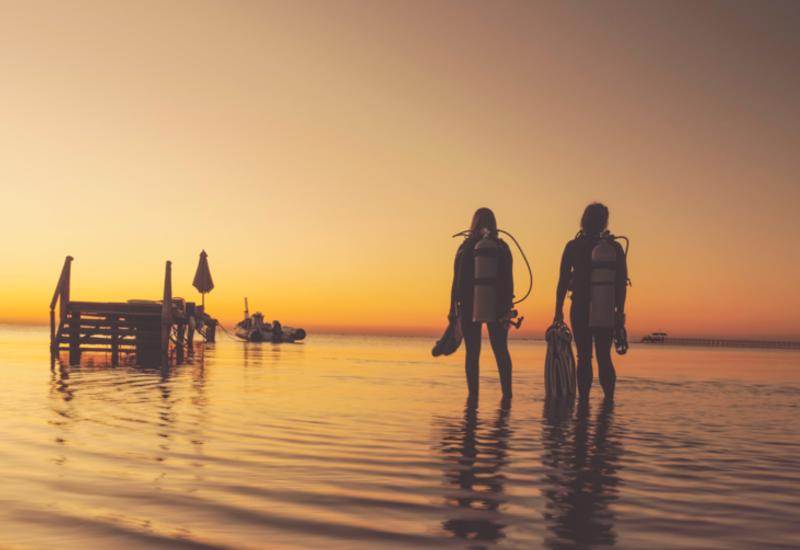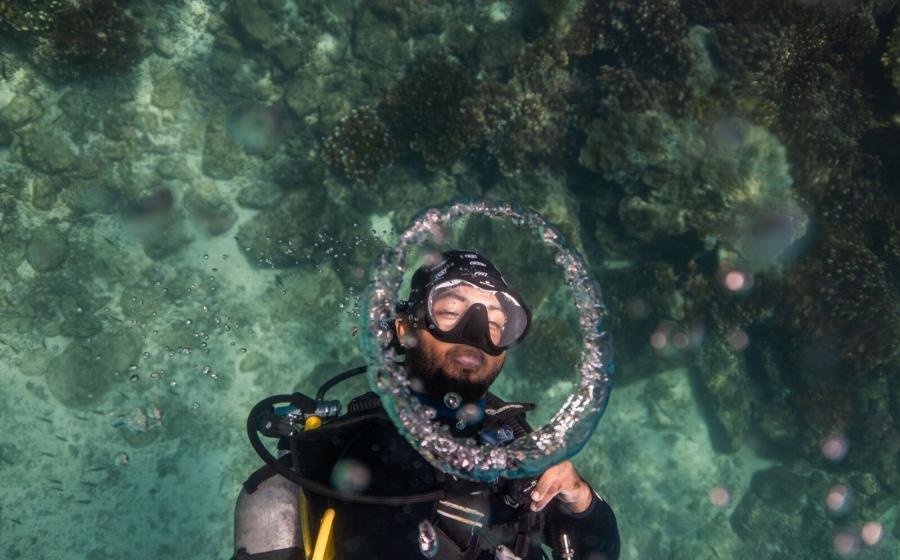History of the Red Sea's Thistlegorm Shipwreck
How a WWII steamship loaded with supplies for British troops was turned into an undersea time capsule — and one of the most-dived wrecks in the world.
The SS Thistlegorm is often heralded as the most popular wreck in the world. Not surprising, given its well-preserved structure, wealth of WWII artifacts and the fact that it sits within recreational scuba diving limits. Learn how the ship — and its trove of trucks, tanks and trains — ended up on the bottom of the Red Sea for scuba divers to explore.

ShutterstockThe Thistlegorm is an underwater museum filled with WWII artifacts for scuba divers to explore.
Thistlegorm’s History Above the Water
Thistlegorm was built by Joseph Thompson & Sons in Sunderland, England and was launched in June 1940. The 415-foot steamship was driven by a triple-expansion three-cylinder engine with 1,850 horsepower. The ship was owned and operated by the Albyn Line, part of the company’s so-called Thistle ships — all named after Scotland’s national flower. According to James Tunney’s article The Truth Behind the Icon in DIVER magazine, Thistlegorm’s name is Gaelic for “Blue Thistle.” When the ship was called into the war effort, a 4.7-inch anti-aircraft gun and a heavy caliber machine gun — both from the pre-WWII era — were added to the stern of the ship.
Thistlegorm’s Final Voyage
The fourth and final voyage of the Thistlegorm was a delivery of much-needed equipment to British soldiers in Northern Africa. The ship was loaded at its homeport in Glasgow in May 1941. Tunney says that the manifest stated that the ship was carrying only motor parts, but in reality, every inch of the ship was filled with equipment ranging from boots and rifles to motorcycles and locomotives.
According to online shipwreck database Wrecksite, Thistlegorm departed on June 2 for Egypt under the command of Capt. William Ellis as part of a large convoy. Instead of journeying through the Mediterranean and risking destruction at the hands of German U-boats, the convoy took a longer route around Africa — a journey of more than 12,000 miles.
Tunney says Thistlegorm was joined by the HMS Carlisle for additional protection after it stopped to refuel in Cape Town, South Africa. When the ships finally reached the Sinai Peninsula around the third week of September, they found that a collision had closed the entrance to the Suez Canal. The ships waited at a spot designated as Safe Anchorage F while the obstruction was cleared. Thistlegorm remained at anchor for two weeks with its engines off as it waited for its turn to leave. As it turned out, Thistlegorm would be waiting a long time — 76 years and counting.

ShutterstockScuba divers are drawn to Thistlegorm's collection of WWII supplies including BSA M20 and Norton 16H motorcycles.
Sinking of the Thistlegorm
At some point during the Thistlegorm’s journey to the Red Sea, German intelligence received reports of a large troop transport ship in the area — Tunney speculates that this was most likely the Queen Mary, which was carrying 1,200 troops to Africa. By the time the Luftwaffe had finally dispatched planes to bomb the transport vessel the night of October 5, 1941, Thistlegorm had already arrived at its final anchorage.
Two German twin-engine Heinkel He111 bombers searched through the night but were unable to find their target. When they reached their turnaround point, the planes split up in hopes of finding another use for their payload on their way back to Crete. One plane spotted Safe Anchorage F and targeted the largest ship it saw — the Thistlegorm.
The plane swooped in and dropped two bombs, which struck cargo hold four at approximately 1:30 am on October 6, 1941. The bombs’ impact was bolstered by the ammunition stored within the ship, resulting in an explosion strong enough to send the two Stanier 8F locomotives stored on deck flying through the air and rip the ship in half. According to Tunney, the explosion was so bright that it gave away the position of the Rosalie Moller to the other Luftwaffe plane, which returned to sink the ship two days later.
Thistlegorm sank quickly and suffered nine casualties out of the 42 men aboard. Five of the men who died were Royal Navy personnel who were likely manning the guns on the stern, close to the impact site. The death toll would likely have been higher had it not been for the weather. Tunney says that it was an exceptionally warm night and many crew members had been sleeping on deck.
The survivors were picked up by the Carlisle. Captain Ellis would later be awarded an Officer of the Most Excellent Order of the British Empire by King George VI for his actions, and crewmember Angus McLeay was awarded the George Medal and the Lloyds War Medal for Bravery at Sea after rescuing another crewmember from the burning ship.

ShutterstockScuba divers will find Thistlegorm's anti-aircraft gun and machine gun on the stern of the wreck.
Scuba Diving the Thistlegorm
Local Bedouin fishermen have been fishing off Thistlegorm almost since the ship sank off the west coast of the Sinai Peninsula in the Straits of Gubal, but its “discovery” is credited to the famous ocean explorer Jacque-Yves Cousteau, who documented his visit to the wreck with a film in 1955. It wasn’t until the ’90 s that the site became a popular wreck-diving destination.
The wreck is broken into two pieces, with the stern twisted 90 degrees, lying on its port side at 105 feet. The bow is shallower and sits upright at about 52 feet. The 415-foot ship is packed with vehicles, munitions, weapons and other paraphernalia from WWII. The size of the ship and the richness of its contents means you’ll want to do multiple dives to fully appreciate all this site has to offer.
The stern is where you’ll find the ship’s gigantic propeller, as well as the two anti-aircraft guns mounted on deck. The impact site and former cargo-hold-turned-debris-pile are where you’ll find Mark II Bren Carrier Tanks (overturned and tossed about like a child’s playthings), crates of munitions spilled across the rubble, rubber boots and other loose artifacts.
Forward of Thistlegorm’s fatal wound are three intact cargo holds filled with grenades, mines, munitions, Morris cars, Bedford Trucks, BSA M20 and Norton 16H motorcycles, Enfield carbines, artillery, Bren guns, spare tank and aircraft parts, Wellington boots, hospital and radio equipment and so much more.
On deck the sights include the captain’s cabin and bridge, the anchor winch and the tank and railway freight cars that had been intended to run behind two locomotives — which can now be seen on the seafloor off either side of the wreck.
The vehicles and other artifacts are the main draw for scuba divers visiting this underwater museum, but you’ll also find marine life scattered throughout the wreck. Keep a look out for soldierfish and sweepers stationed in the holds, crocodilefish laying on the deck floor, patrolling trevally, schools of teira batfish, and hawksbill turtles.
Thistlegorm is considered an advanced dive and scuba divers can expect strong currents. They can also expect crowds, because it is a very popular wreck. Diving with a liveaboard operator gives you the best chance to get in early and beat the day boats, which must travel four hours from Sharm el Sheikh.
Depth The wreck starts at a little more than 52 feet and the deepest point is the prop, sitting at about 105 feet.
Visibility Visibility usually range from 30 to 90 feet.
Temperature Water temperature can be as low as 68 degrees Fahrenheit in the winter and in the lower 80s in the summer.
Need to Know All areas of the Thistlegorm are accessible to recreational scuba divers, but the wreck is in a remote area where strong currents are common and the dives can be deep with long bottom times. While the holds are wide-open and there are many vertical exits, most of your no-deco time will be spent inside dark, cramped interiors, so it is a good idea to have training and experience suited for this kind of overhead environment.
Operators Emperor Divers, Sinai Divers

ShutterstockThistlegorm's cargo holds are filled with trucks, jeeps, tanks and other WWII vehicles.










